Missile system M142 HIMARS (USA). Characteristics and influence on the situation
The 14 of June at the airport of Tallinn (Estonia) landed a C-17 Globemaster III military transport aircraft from the 164 transport aircraft wing of the Tennessee National Guard. On board the aircraft were two combat vehicles of the M142 HIMARS type. This technique, also owned by the National Guard, was delivered to the Baltic States to participate in the current Saber Strike 2016 exercises. As part of the exercises, the missile complexes were to go to one of the ranges that became a platform for maneuvers, and then attack conventional targets.
The transfer of missile systems attracted the attention of foreign and domestic press. For example, in some foreign publications, the participation of two HIMARS systems in the Baltic exercises was called an "unequivocal signal to Moscow". Officials of the Pentagon, in turn, have done without such bold and even provocative statements. According to official data, rocket complexes are attracted to the exercises in order to work out the interaction of the armies of several countries and to gain experience in working at new test sites.
Foreign press reviews about the M142 HIMARS complexes and their capabilities, as well as the political implications of the transfer of such equipment cannot but attract attention. Consider these systems and try to determine what kind of threat they can pose to Russia, being deployed in the countries of Eastern Europe.
The first work on the HIMARS (High-Mobility Artillery Rocket System) system was carried out in the eighties. The M270 MLRS MLRS that existed at that time met its requirements in terms of its main characteristics, but its mobility might not be sufficient for solving some tasks. As a result, it was required to create a new similar system in a more mobile version. By the beginning of the nineties, the possibility of creating a relatively compact launcher with six guides for 227-mm rockets, which could be placed on an airborne chassis, was determined.
In the middle of 1990, the Pentagon formed the requirements for a new multiple launch rocket system with high mobility and mobility. After a few years, a prototype of the HIMARS system was put to the test, which, however, was noticeably different from subsequent production machines. At the beginning of 1996, Lockheed Martin was awarded a contract to complete design work and build several full-fledged prototypes of the new system. The fulfillment of the terms of this contract allowed us to complete the project and prepare new combat vehicles for mass production. After a series of necessary tests, in 2003, the M142 HIMARS complex was put into service. It should be noted that the adoption of weapons did not lead to a halt of various works. The creation of new ammunition for the missile complex continues for a long time and does not stop until now.
When developing the new HIMARS project, the main task was to ensure high mobility of the equipment on the battlefield, as well as to simplify the transfer of military transport aircraft. Such requirements led to the choice of one of the available serial wheeled chassis. In addition, it was decided to recycle the existing launcher with a reduction in ammunition in half. As a result, the missile system retained some basic characteristics, as well as improved some of the other parameters.
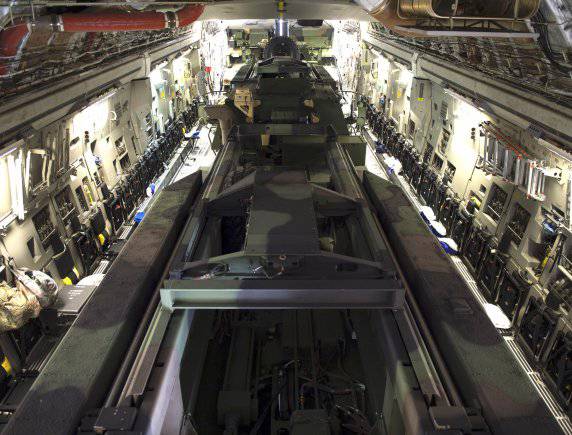
Two combat vehicles in the cockpit of a military transport aircraft. Photo of Army.mil
The basis for the M142 HIMARS combat vehicle is a three-axle all-wheel drive chassis of the FMTV family with a 5 tonnage. The base car is built according to the bonded layout and receives a set of necessary units. Thus, serial equipment can receive both regular and protected cockpit. Behind the cab on the chassis mounted unit of additional equipment, and the cargo area of the frame is given for the placement of a turntable with a launcher.
The total length of the vehicle is 7 m, the width of the 2,4 m, height (in the stowed position) is 3,2 m. The complex is managed by a crew of three, located inside the cabin. According to the company-developer, if necessary, all operations to control the combat vehicle can be performed by one person.
At the rear of the chassis is placed a turntable with drives for horizontal and vertical guidance. It is possible to shoot in any direction with elevation angles from -2 ° to + 60 °. The control of the pickup drives is carried out from the console located in the cabin. The fire control systems of the M142 HIMARS complex are unified with the equipment of the MLRS complex.
The launcher of the M142 machine is designed taking into account the developments in the MLRS system, and also uses some of its units. The installation is a U-shaped device with mounts for interchangeable guide packages. In addition, on the top of the launcher placed faucet recharge system. This launcher design allows the HIMARS complex to use standard transport and launch containers made for M270 MLRS.
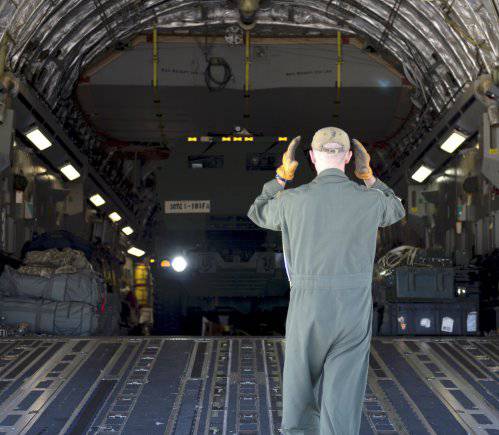
Unloading machinery in Estonia. Photo of Army.mil
The container is a block of several (in the standard version - 6) fiberglass transport-launch containers of tubular design with guides to give the missiles rotation. Containers are interconnected by several frames-clips, which allows simultaneous operations with the entire package. The ammunition is placed in containers at the factory, and then sealed covers are installed. Removing or otherwise servicing the missiles before firing is not provided.
For recharging, the launcher turns back in the direction of travel, after which the lifting frame of the lifting device extends from its upper part. Using a set of cables and hooks, the package of containers is lifted from the ground or from the cargo platform of the transport vehicle, after which it is placed inside the launcher. Dismantling of the used package is carried out in the same way.
An important feature of MLRS and HIMARS multiple launch rocket systems is a wide range of compatible ammunition. Due to the lack of its own launch guides, the machine can carry containers with missiles of various types and different calibers. Thanks to this self-propelled launcher can carry from one to six missiles with different characteristics.
Being a simplified and lightweight version of the M270 MLRS, the M142 HIMARS system retains the ability to use existing ammunition. In addition, unified and new types of rockets. Products borrowed from an existing project are often referred to as MFOM (MLRS Family of Munitions - “MLRS Ammunition Family”). This family includes both unmanaged and managed systems. All MFOM shells have a caliber of 227 mm and a length of 3,94 m, but differ in weight and combat load. Regardless of the types of missiles, the HIMARS launcher can carry ammunition of six shells.
The following missiles have been developed for MLRS and HIMARS:
- M26 and its modifications. Equipped with cumulative fragmentation ammunition in quantities from 518 to 644 pieces. Flight range, depending on the modification, ranges from 32 to 45 km;
- M30. Projectile with 404 submunitions and a combined control system based on inertial and satellite navigation. Able to fly 84 km;
- M31. Modification of the M30 product with a high-explosive fragmentation warhead weighing 90 kg. The remaining characteristics do not change.
A number of new missiles compatible with M270 and M142 have also been developed by several foreign countries. They are designed to solve various problems and differ in different characteristics.
When needed, multiple rocket launchers can be used as tactical missile systems. In this case, the AFOM (Army TACMS Family of Munitions - ATACMS Army Ammunition Family) guides should be mounted on the launcher. Products of this line, also known as M39 or MGM-140, are unguided and guided missiles with different combat payloads and various range indicators. In service are the following missiles:
- MGM-140A. An unguided rocket with a range of 128 km. Combat load in the form of 950 high-explosive submunitions;
- MGM-140B. Rocket with a range of 165 km and a combined inertial-satellite control system. Carries 275 high-explosive ordnance;
- MGM-140E. At the moment, the most advanced development of the family, differing flight range to 270 km. Used control system. The target is delivered 227-kg high-explosive fragmentation warhead.
After adopting the M142 HIMARS complex, the development of ammunition for it did not stop. For this reason, the development of new missiles for one purpose or another continues to this day. The focus is on the development of MGM-140 ATACMS missiles. Such weapons can solve problems that are inaccessible to the ammunition of the MFOM family, which causes an increased interest on the part of the customer. Attempts were also made to refine the complex for the use of existing and advanced anti-aircraft missiles.
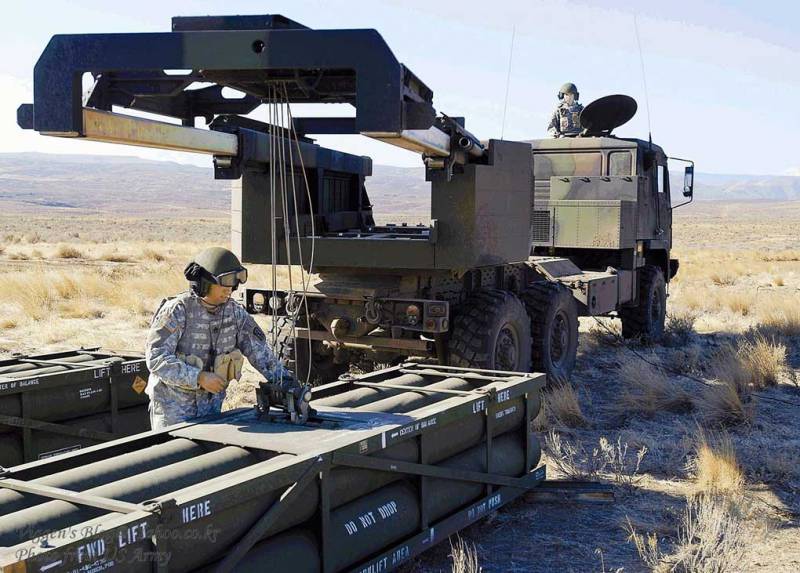
Recharge process. The lifting device is extended, the package of containers is being prepared for loading. Photo Rbase.new-factoria.ru
After carrying out all the necessary tests, the new M142 HIMARS complexes went into series. By the middle of the two thousand years, this technique entered the army, after which its development began. Later, several new contracts were signed for the supply of HIMARS systems for the army, the Marine Corps and the National Guard. To date, American gunners from various structures have received a total of 417 missile systems and a significant number of ammunition of all compatible types.
Over time, part of the serial equipment was sent to hot spots. So, in February, 2010, one of the units armed with M142, participated in the fighting for the first time. During one of the operations in Afghanistan, two missile launches were made. The products seriously deviated from the required trajectory, as a result of which they fell away from the chosen target and led to the death of several civilians. Until the end of the investigation, the operation of HIMARS systems was suspended. In the future, the problems were solved, which allowed to return the complexes to operation.
Since November 2015, HIMARS complexes sent to Iraq have been involved in the fight against terrorists. Since then, several hundred missile launches of various types on various enemy targets have been carried out. Due to the continuing unfavorable situation in the region, it should be expected that the operation of these systems will continue for a long time, and the total consumption of ammunition will increase several times in comparison with the existing indicators.
A few days ago, two M142 HIMARS military vehicles of the Tennessee National Guard were deployed to Estonia to participate in the joint NATO exercise Saber Strike 2016. During this event, the crews of the complexes successfully coped with the tasks set by completing the transfer to the required landfill, followed by firing at training targets.
A number of foreign media called the transfer of HIMARS systems to the Baltic States "a signal for Moscow." Recently, relations between Russia and NATO have worsened, and regular exercises in Eastern Europe, at a minimum distance from Russian borders, only worsen the situation. In addition, unfriendly publications in the foreign press do not contribute to the establishment of relations.
It should be noted that the authors of the version of the "signal" are to a certain extent right. The transfer of multiple launch rocket systems can indeed be regarded as an aggressive step that does not contribute to defusing the situation. With the possibility of attacking targets at distances from 30 to 270 km, such complexes can be dangerous for border objects. The existence of a wide range of combat units and the relatively high accuracy of the adjusted ammunition only increase the risks and also make the threat more serious.
The latest American missile systems should be considered with Russian developments of a similar purpose. First of all, the HIMARS system forces us to recall the MLRS 9K58 Smerch. Combat vehicles of this type are capable of making a salvo of 12 mm 300 shells. Depending on the type of ammunition used, targets are hit at a distance of up to 70-90 km. Combat units of various types are delivered to targets, both unitary and cluster with different submunitions.
The modernization project “Tornado-S” is also being implemented, within the framework of which the control system of the complex is being updated, and new ammunition is being created. Missiles capable of flying up to 120 km, while maintaining combat qualities at the level of existing missiles.
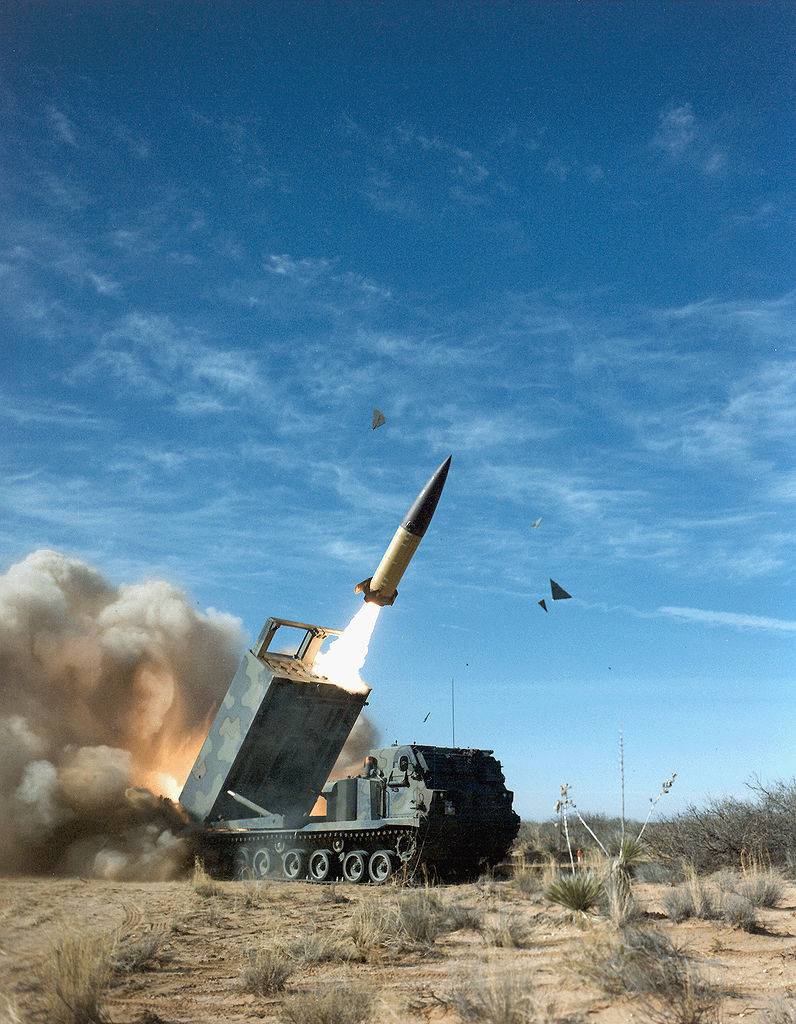
MLRS M270 MLRS fires an ATACMS missile. Photo of Wikimedoa Commons
The M142 HIMARS combat vehicle can be used not only as a multiple rocket launcher system, but also as a tactical missile system. In this case, the Russian counterparts of the complex can be considered the systems "Tochka-U" and "Iskander." Depending on the type of rocket, the Tochka-U complex is capable of hitting targets at distances up to 120 km, and Iskander up to 500 km. Also offered various missile warheads.
There are concerns that M142 HIMARS can be deployed on a permanent basis in Eastern Europe. In this case, you will need some kind of response to new threats. It is noteworthy that one of the options for such a response already exists. Earlier in foreign and domestic sources, information appeared about the transfer of Iskander complexes to the Kaliningrad region. In addition, such transport tasks were repeatedly worked out during the exercise. Due to the deployment of such systems in the western regions of the country, including in the Kaliningrad region, the possibility of hitting targets in the territory of large parts of Eastern Europe is provided.
The combination of the characteristics of the M142 HIMARS missile systems, as well as the characteristic features of the systems themselves and their ammunition, make it necessary to consider such a technique to be quite a serious threat requiring an answer. Whether such a technique will remain in the Baltic States, or will be returned to the United States after the completion of the current exercise, is still unknown. Nevertheless, such risks need to be taken into account now and build appropriate plans. How the situation will develop further - time will tell.
On the materials of the sites:
http://army.mil/
http://lockheedmartin.com/
http://tvzvezda.ru/
https://rg.ru/
http://rbase.new-factoria.ru/
http://globalsecurity.org/
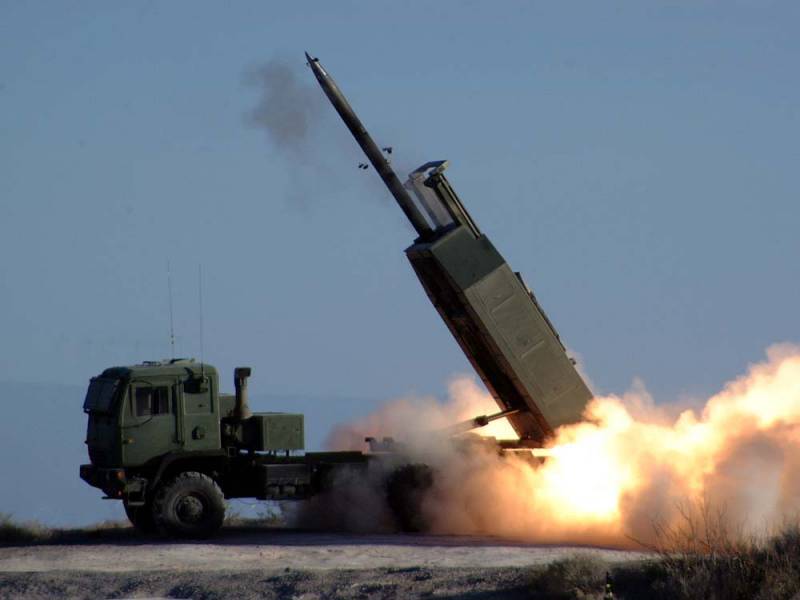
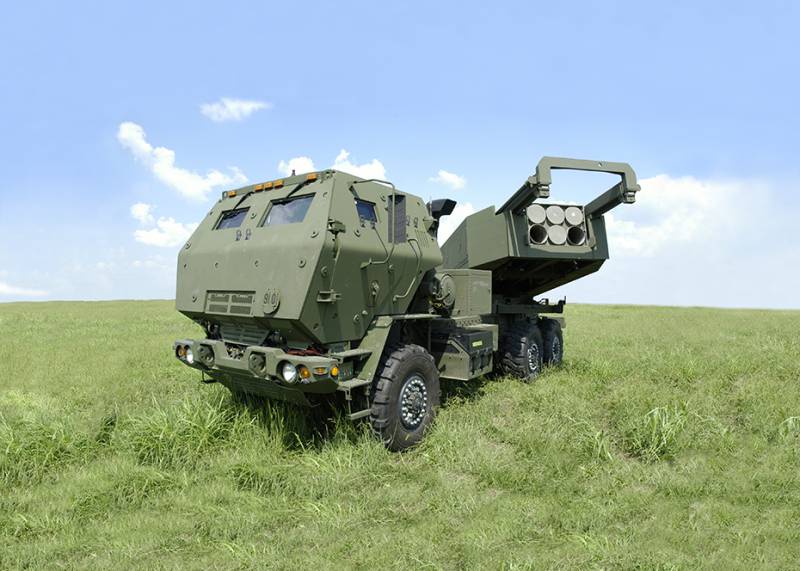
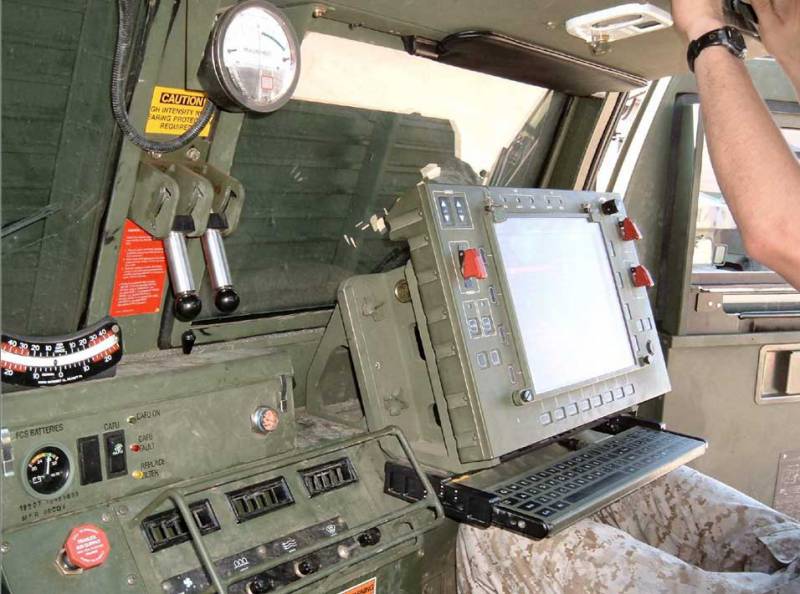
Information